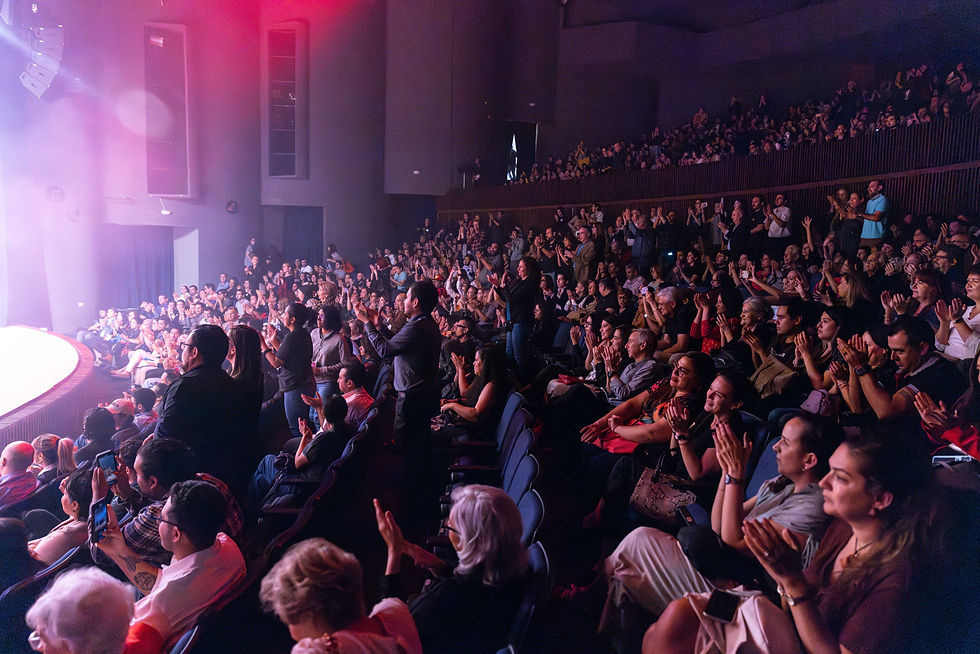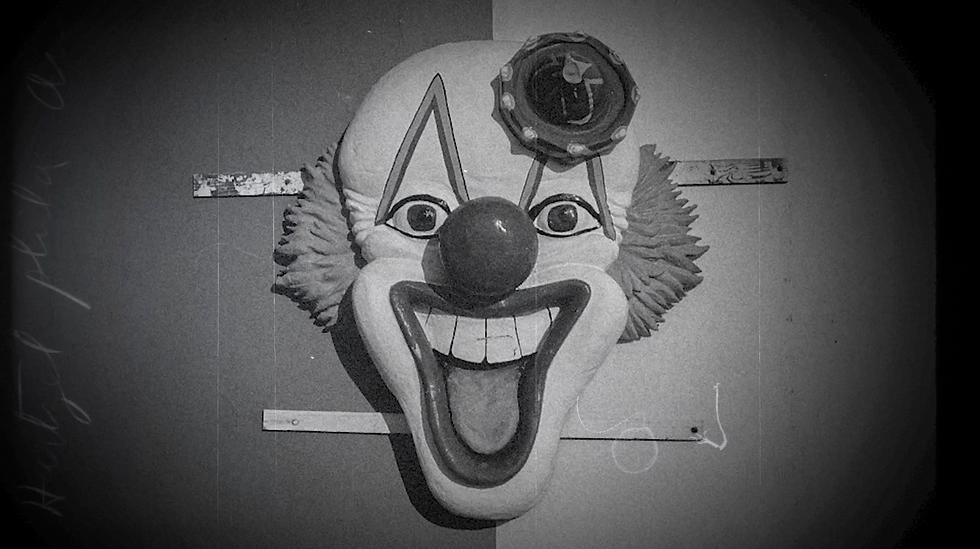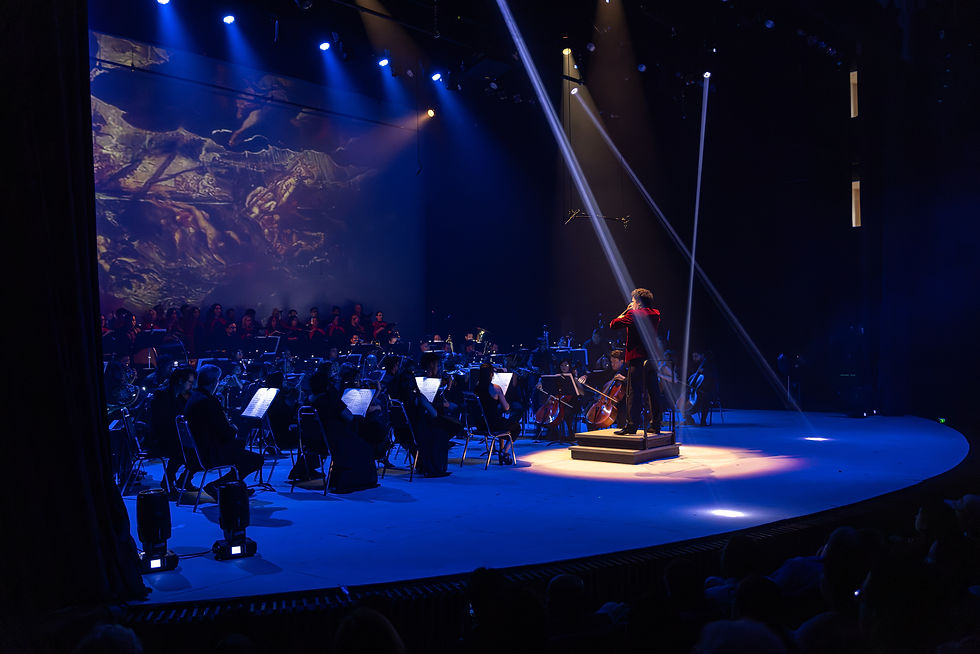Macabra:
The dark side of music

I. Fear of the dark
Toccata and Fugue in D Minor
J.S. Bach
Darkness is one of humanity’s oldest fears—an instinct from childhood that never leaves us. Bach’s iconic Toccata and Fugue paints a powerful contrast between light and shadow, embodying the eternal struggle between fear and clarity.
To accompany this piece, we projected shadow-based visuals that evoked the primal fear of darkness and the unknown. The blurred hands and figures pressing through the surface symbolized unseen forces and childhood fears—those irrational terrors we feel in the dark when form and meaning dissolve. Just as Bach’s composition contrasts light and shadow in sound, the visuals echoed that same duality through movement and distortion, turning the stage into a space where fear and imagination blur.


Immersive Symphonic Experience
Role:
-
Concept / Ideation
-
Co-producer
-
Art Director
-
Video Producer
-
Screenplay
-
Event Marketing
Client:
-
La Súper
-
Patronato La Superior
Partners & Collaborators:
-
Alejandro Garza
-
Orion Productions
-
Jaime SIerra
Macabra was a programmatic concert that invited the audience to explore fear through a dark and mysterious soundscape, where every piece, every chord, and every note evoked intense emotions and awakened the most primal instincts.
It was a musical journey that delved into themes such as death, madness, suffering, darkness, and war—through great compositions ranging from the Middle Ages to modern times.
Overview
La Súper Orquesta was conducted by the renowned Monterrey-born maestro Abdiel Vázquez, and several pieces in the program were performed in collaboration with the Coro Nuevo León, under the direction of Juan David Flores.
The music was enhanced by striking imagery, video projections, and ambient lighting for each piece, creating a fully immersive visual atmosphere.
"Macabra, a flawlessly produced multimedia concert showcasing the brilliance of 'La Súper'"
— Lázaro Azar, Music Critic
Macabra:
The Dark side of music

The concert was conceived with two distinct yet equally ambitious objectives. On one hand, it needed to function as a high-end event for VIP guests, serving as a fundraising gala to support the orchestra. On the other, it had to be a compelling and accessible theatrical experience for the general public in the city.
As a result, the production demanded a dual approach: it had to meet the expectations of a discerning, culturally engaged audience—where quality and impact were crucial for fundraising success—while also offering the flexibility to adapt seamlessly to two very different venues.
The Challenge
The first venue was an open-air space within the Historic Central Courtyard of the ESMDM, and the second was Auditorio San Pedro, a traditional indoor theater. The production had to be both visually striking and technically versatile to meet the unique characteristics and requirements of each setting.



The concept
The word Macabra evokes images of darkness, grotesqueness, and the unsettling aspects of human experience—particularly those tied to death, decay, and the unknown. It refers to something that elicits a visceral reaction: fear, aversion, or even morbid fascination. This emotional intensity was precisely what the concert aimed to explore.
The name Macabra was chosen not just for its dramatic weight, but because it perfectly captured the essence of the program
Conceived from the outset to coincide with the Halloween and Day of the Dead season, the entire experience was built around a carefully crafted narrative that wove together each musical piece through a thematic exploration of fear.
The program traced the many forms of fear that dwell within the human condition, with each composition selected to embody and illustrate a particular kind. Every piece was supported by evocative visuals and lighting design, thoughtfully orchestrated to convey that specific fear in a way that resonated deeply with the audience’s collective imagination.

II. Fear of rejection
In the Hall of the Mountain King
Edvard Grieg
The fear of rejection and obsession grows quietly until it consumes us. Grieg’s piece builds with relentless intensity, mirroring the spiral into fixation and the chaos it leaves behind.
To reflect the obsessive descent portrayed in Grieg’s In the Hall of the Mountain King, we projected a sequence of porcelain dolls—initially pristine and elegant—gradually shifting into images of cracked, soiled, and abandoned figures. This visual transformation mirrored the emotional arc of the piece: from innocence and the desire for acceptance to a distorted fixation that ultimately corrodes beauty and leads to decay. The dolls became haunting metaphors for the loss of self under the weight of obsession.


III. Fear of nature
Winter (F minor)
A. Vivaldi
Nature’s brutal indifference has long terrified humankind. Winter from The Four Seasons captures a frozen, desolate world where wind and sorrow pierce the soul with every note.
To accompany Winter, we projected a progression of snowy imagery—beginning with the quiet stillness of softly falling snow and evolving into a violent blizzard, culminating in a thunderous snowscape. This visual journey mirrored Vivaldi’s musical narrative: from cold melancholy to nature’s terrifying fury. The storm served as a visceral reminder of nature’s power—unfeeling, overwhelming, and indifferent to human fragility.


IV. Fear of the unknown
Mars, the Bringer of War
G. Holst
Fear of the unknown—of fate and destruction—echoes through Mars. Holst conjures a soundscape of apocalyptic force, inspired by astrological dread and cosmic violence.
To evoke the cosmic dread of Holst’s Mars, we projected surreal, alien imagery—barren planetary landscapes, shifting red light, and viscous, otherworldly fluids. These visuals suggested a world abandoned by reason, where technology has failed and the unknown reigns. The imagery underscored the music’s apocalyptic pulse and the fear of what lies beyond our comprehension—unseen, untamed, and inevitable.


IV. Fear of loss
Lacrimosa
W.A. Mozart
The pain of loss and loneliness finds voice in Mozart’s Lacrimosa. Written near his death, it drips with sorrow and mystery—believed to be his own requiem.
To accompany Lacrimosa, we projected the image of a sorrowful stone figure beneath a darkened sky, gradually morphing into a monstrous visage. This transformation reflected the emotional erosion caused by grief—how pain, over time, distorts even the most sacred memories. The statue’s descent into horror became a visual metaphor for loss turning into despair, echoing the haunting lament of Mozart’s final composition.


V. Fear of death
Night on Bald Mountain
M. Mussorgsky
Death as nightmare: witches, shadows, and a descent into darkness. Night on Bald Mountain is a feverish vision of terror, ending only when we wake.
For Night on Bald Mountain, we began with a haunting forest shrouded in fog, gradually revealing ghostly apparitions that emerged like hallucinations from a fever dream. As the music intensified, the forest gave way to a monstrous gaze—cold reptilian eyes and serpent-like skin—representing death itself as a living, watching presence. The projections captured the nightmarish descent into darkness and dread, echoing Mussorgsky’s vision of fear unleashed before the return to silence.


VI. Fear of insanity
Danse Macabre
C. Saint-Saëns
Madness blurs beauty and horror. Danse Macabre is a wild waltz between the grotesque and the elegant, evoking our fear of losing touch with reality.
To reflect the twisted waltz of Danse Macabre, we projected vintage clown masks and early 20th-century footage, gradually distorting into kaleidoscopic nightmares. As the music spiraled into chaos, the clowns’ faces shifted between joy, sorrow, rage, and madness—becoming symbols of the fine line between comedy and horror. The visuals echoed the piece’s theme: the descent into madness hidden behind a painted smile.


VII. Fear of war
Slavonic March
P.I. Tchaikovsky
The cycle of peace shattered by war. Tchaikovsky offers moments of calm—only to be broken by the brutal march of conflict and the roar of destruction.
To accompany Slavonic March, we projected a chronological journey through art history—beginning with serene 18th-century pastoral paintings and evolving into increasingly chaotic depictions of war. As the music intensified, the visuals transitioned through Romanticism, Modernism, and finally into raw Expressionism, culminating in images of atomic devastation. This visual arc mirrored Tchaikovsky’s musical contrast between peace and violence, and reflected humanity’s long, painful history of beauty shattered by conflict.


VIII. Fear of destiny
Dies Irae / Tuba Mirum
G. Verdi
Divine judgment looms in Verdi’s Dies Irae—a thunderous cry of fear and awe. The Tuba Mirum follows, offering a final glimpse of hope beyond the darkness.
To accompany Verdi’s Dies Irae / Tuba Mirum, we projected a sequence of Final Judgment paintings—from medieval terror to Renaissance grandeur. These evolving visions of damnation and salvation echoed the music’s dramatic arc: the wrath of divine judgment, followed by the distant promise of redemption. The imagery framed the eternal question of fate—condemnation or grace—just as Verdi’s score thundered and wept in equal measure.


IX. May fortune be with you
O Fortuna
Carl Orff
Few works capture the terror of fate like O Fortuna. With its thunderous rhythms and choral power, it evokes the fear of life’s unpredictability—the wheel of fortune that lifts and crushes without warning. Orff’s iconic opening and closing movement from Carmina Burana is a force of destiny unleashed.
To visualize O Fortuna, we projected a growing flame that swelled with the intensity of the music—culminating in an all-consuming wall of fire. This rising blaze mirrored the relentless force of fate depicted in Orff’s score: unpredictable, powerful, and merciless. Like fortune itself, the fire offered no control—only awe, terror, and the inevitability of being consumed by something far greater than ourselves.


Screenplay
As a unifying thread, the concert featured a carefully crafted narrative delivered through a voice-over that introduced each piece before it was performed. This guiding voice led the audience through the thematic landscape of Macabra, presenting the type of fear associated with each composition and offering a brief yet meaningful reflection on its emotional essence.
Before each performance, the narration provided context for the piece—revealing how its musical elements, such as melody, rhythm, and harmony, came together to give shape to deeply human fears: darkness, death, loneliness, madness, war, and more. This narrative device allowed the audience not just to listen, but to experience each work on a more intimate emotional and psychological level, creating a profound connection between the music and the universal anxieties that dwell within us all.







A comprehensive two-month public relations, email, and social media campaign was launched to promote the Macabra concert experience.
Through a strategic mix of targeted content and paid advertising on Meta platforms—including Facebook and Instagram—the campaign successfully reached and engaged key audience segments. As a result, it not only met its fundraising objectives during the VIP gala but also achieved a full house at the theater performance.
Event Marketing
The campaign was anchored in a captivating series of teaser clips, trailers, and short-form videos, each crafted to build anticipation and emotionally connect with the public. These visual assets highlighted the concert’s immersive atmosphere and thematic depth, drawing audiences into the dark, theatrical world of Macabra well before they entered the venue.

















